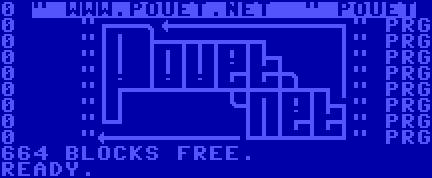projected dot-cube in assembler
category: code [glöplog]
any ideas for optimization?
i did the same with just ploting the pixels and came to 41 bytes:
but the reason why i am asking is because i want the projection routine to work in real-time. hence doing rotation in pure assembly is the next step for the former routine.
Code:
org 100h
mov al, 13h
int 10h
mov ax, 0a000h
mov es, ax
mov bx, -2
mov cx, 8 ;8 vertices
L1:
add bx, 6
;translate z
mov ax, [cube+bx]
add ax, [fovz]
mov [cube+bx], ax
;X Coordinate
mov ax, [cube+bx-4] ;put x-coord in ax
mul word [fovz] ;ax=al*m8
cwd
idiv word [cube+bx] ;z-coord ;ax=ax/reg
mov [proj], ax
;Y Coordinate
mov ax, [cube+bx-2] ;y-coord
mul word [fovz]
cwd
idiv word [cube+bx] ;z-coord
mov [proj+2], ax
;plot projected coords
push ax
push bx
;x-coord
mov bx, [proj] ;bx = x
add bx, 160 ;bx = x + 160
mov si, bx ;si = x
;y-coord
mov ax, 320
mov bx, [proj+2] ;bx = y
add bx, 100 ;bx = y+100
mul bx ;ax = (y+100) * 320
add si, ax ;si = x+160 + (y+100) * 320
mov byte [es:si], 15
pop bx
pop ax
loop L1
a:
jmp a
fovz dw 255
cube dw -40, -40, -40
dw 40, -40, -40
dw 40, 40, -40
dw -40, 40, -40
dw -40, -40, 40
dw 40, -40, 40
dw 40, 40, 40
dw -40, 40, 40
proj times 2 dw 0
i did the same with just ploting the pixels and came to 41 bytes:
Code:
org 100h
mov al, 13h
int 10h
les bp,[bx]
mov cx, 8
L: mov si, [cube+bx]
mov byte [es:si+255], 15
add bx, 2
loop L
cube dw 16833, 16927, 21006, 21074, 42767, 42834, 46913, 47007
but the reason why i am asking is because i want the projection routine to work in real-time. hence doing rotation in pure assembly is the next step for the former routine.
if you're optimizing for size, you can just go for the equivalent of for(int i=0; i<8; i++) { x = (i&1)?-40:40; y = ... } instead of storing the coordinates
yes, good point. thank you
Quote:
I want the projection routine to work in real-time
is it not working in real-time now? What hardware are you using?
trc_wm: hm. dosbox. what? you dont see the dots?
its not tested on a real dos btw.
Avoud to use stored values, try to generate all on the fly.
You can save a lot of space
For 8 point it might be like
or even more aggressive
(gives cube 65x65x65)
You can save a lot of space
For 8 point it might be like
Code:
inc bx
mov al, 40
test bl, 1
jz AX
sub al, 80
AX: cbw
push ax
mov al, 40
test bl, 2
jz AY
sub al, 80
AY: cbw
push ax
mov al, 40
test bl, 4
jz AZ
sub al, 80
AZ: cbw
push ax
;pop them and project coordinates
inc bx
and bl, 7or even more aggressive
Code:
inc bx
test bl, 1
salc
xor al, 64
AX: cbw
push ax
test bl, 2
salc
xor al, 64
AY: cbw
push ax
test bl, 4
salc
xor al, 64
AZ: cbw
push ax
...
inc bx
and bl, 7(gives cube 65x65x65)
Oops, change first "inc bx" to "L:"
and add at teh end "jmp L"
and add at teh end "jmp L"
trc_wm: sorry, i read your line wrong. yes its working in RL.
frag: fantastic! actually i need to understand whats going on in that code. if it is equal to gargaj's C-code then i understand. the salc and test-instructions i havent learned yet, so i don't yet fully understand em.
frag: fantastic! actually i need to understand whats going on in that code. if it is equal to gargaj's C-code then i understand. the salc and test-instructions i havent learned yet, so i don't yet fully understand em.
i need to wrap up the disassembler in Visual C/C++ and study those instructions. but i need a break now :)
props for showing actual effort. good luck.
dunno if this is shorter. it looked scary to implement that one frag.
anyway. this is what i got now
anyway. this is what i got now
Code:
mov al, 128
L: rol al, 1
cmp al, 8
jnz L2
mov al, 1
L2: mov word [cube+bx], 40
test cl, al
jnz L3
mov word [cube+bx], -40
L3: add bl, 2
loop Ljust stripped a few byte(s). forgot
Code:
L: rol al, 1
cmp al, 8
jnz L2
mov al, 1
L2: mov word [cube+bx], 40
test cl, al
jnz L3
neg word [cube+bx]
L3: add bl, 2
loop Live changed to NASM. when i do a mul bx, cx for example. is bx the destination operand or does it mul bx and cx (bx*cx) and dest in ax? just wondering
just did it in ax. didnt bother
There are three "types" of imul:
- imul cx,bx,12345: cx = low 16 bits of (bx*12345)
- imul bx,cx: bx = low 16 bits of (bx*cx)
- imul bx: ax = low 16 bits of (ax*bx), dx = high 16 bits of (ax*bx)
very helpful, thanks rrrola
